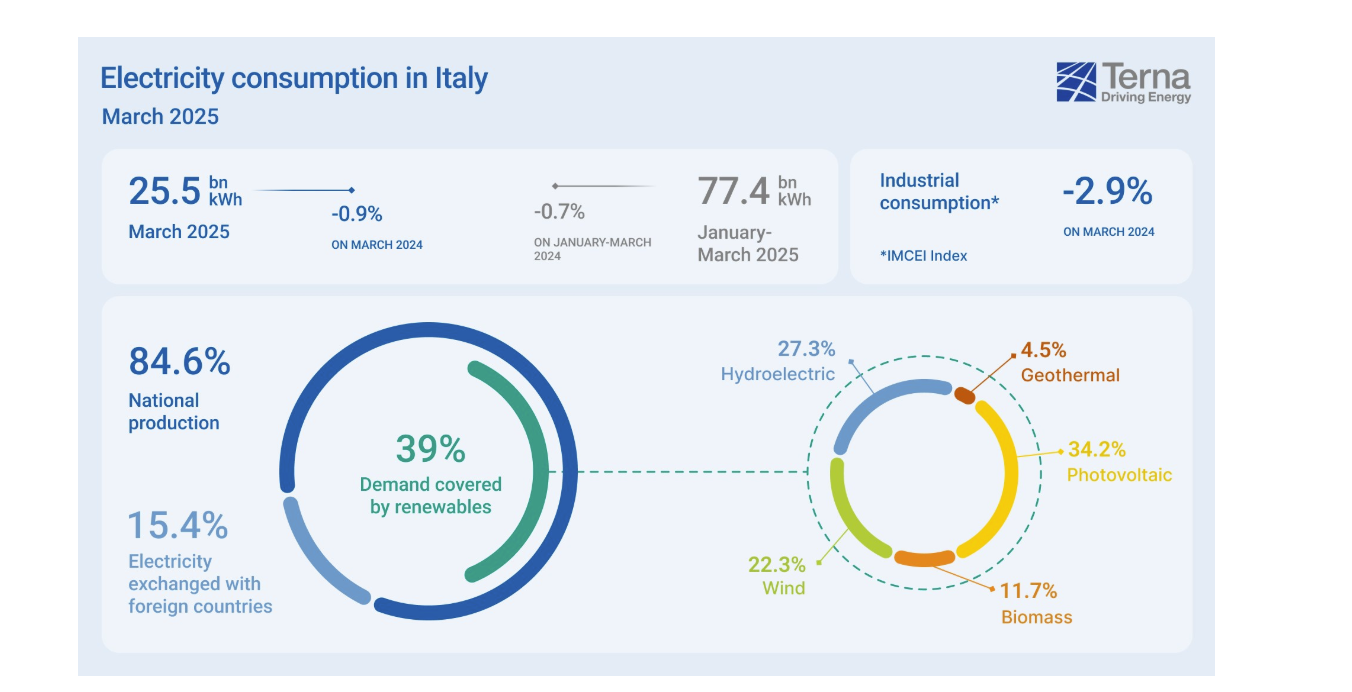According to data from Terna, the Italian national grid operator, in March the country’s electricity demand amounted to 25.5 billion kWh, marking a decrease of 0.9% compared to the same month in 2024. Specifically, March 2025 had the same number of working days as March 2024 (21), and the average monthly temperature was about 1°C lower, although still higher than the ten-year monthly average. The seasonally and temperature-adjusted variation stood at -1.5%.
From a geographical perspective, the year-on-year change in March was negative across all regions: -0.7% in the North, -0.5% in Central Italy, and -1.7% in the South and Islands.
In the first three months of the year, national electricity demand showed a slight decline (-0.7%), a figure influenced by the comparison with a leap year; the adjusted variation is +0.1%.
The IMCEI index developed by Terna, which monitors electricity consumption among so-called “energy-intensive” industries, declined by 2.9% compared to March 2024 (-3.7% adjusted). Growth was recorded in the food, cement/lime/gypsum, and mechanical engineering sectors; declines were observed in chemicals, non-ferrous metals, ceramics and glass, transportation equipment, and steel.
On a month-on-month basis, the seasonally and temperature-adjusted electricity demand figure shows a decline compared to February 2025 (-1.5%). The first quarter of 2025 was broadly stable relative to the final quarter of 2024. Conversely, the IMCEI index posted a positive monthly variation in March, up by 1.3%. Over the first quarter of 2025, the IMCEI index increased by 2.4% compared to the last quarter of 2024.
The IMSER index, developed by Terna based on monthly electricity consumption data provided by selected distribution system operators (E-Distribuzione, UNARETI, A-Reti, Edyna, and Deval), and published with a two-month delay compared to general electricity and industrial data, recorded a year-on-year decline of 1.4% in January 2025.
Turning to Terna’s monthly balance sheet, in March 2025, Italian electricity demand was met 84.6% by domestic production and 15.4% by net imports. Cross-border exchange amounted to 3.9 TWh, marking a 25.9% decrease from March 2024 (5.24 TWh). This reduction is primarily due to lower import flows from the Swiss border.
Specifically, net domestic generation reached 22 billion kWh. Renewable sources accounted for 39% of electricity demand, down from 42.3% in March 2024. Solar (+23.8%) and thermal (+18.6%) generation increased, while hydropower (-33.6%), geothermal (-2.4%), and wind power (-7.2%) decreased. The decline in wind energy marked the third consecutive monthly drop.
In March, newly installed renewable capacity amounted to 777 MW, representing a 52% increase compared to the same month of the previous year. Of this total, 352 MW was connected to the High Voltage grid, 263 MW to the Medium Voltage grid, and 161 MW to the Low Voltage grid. Over the first quarter of 2025, operational renewable capacity increased by 1,596 MW, down by 13% compared to the same period in 2024.
As of 31 March 2025, Italy had a total of 13,682 MWh of energy storage capacity, corresponding to 5,913 MW of nominal power, across approximately 775,000 storage systems.
A detailed analysis of provisional 2024 and 2025 monthly electricity demand is available in the “Monthly Report on the Electricity System”, available under the section “Electric System>>Publications>>Monthly Report” at www.terna.it
































